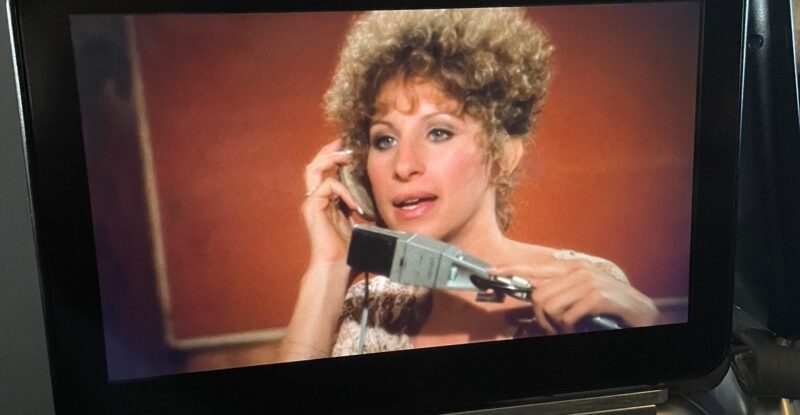What would you watch on a 12-hour flight? That’s the question Panasonic Avionics senior vice president product & strategy Andrew Masson recently posed to his followers on LinkedIn.
Pondering his question, I thought to myself, if I had my druthers, I’d rewatch A Star is Born, the 1976 film starring Barbra Streisand and Kris Kristofferson as well as Tommy Boy, the 1995 comedy starring Chris Farley, 1991’s The Prince of Tides and 1992’s The Last of the Mohicans. I haven’t yet seen this year’s Mission: Impossible – The Final Reckoning, except for those heart-stopping clips of Tom Cruise dangling from a Boeing Stearman biplane, so I reckon that would round out the lineup nicely and keep me occupied for the flight.
What’s striking about my list — and indeed many of the movie titles shared by respondents to Masson’s informal survey — is that we clearly love the classics and gravitate to them, including in flight. But that’s not news to Warner Bros. Discovery. Indeed, when the global media and entertainment company looked at how people spent their time with entertainment over the last year, it found that some of the most watched movies and series were older classic titles.
In the last year, people spent 2.7 billion hours watching Friends. They spent another 1 billion hours watching Supernatural. And they spent 1.1 billion hours watching Shameless, the American comedy drama that ran from 2011 to 2021. To put that 1.1-billion-hour figure into perspective, it equates to taking 30.5 million ultra long-haul roundtrip flights between New York JFK and Singapore.
“Our data shows us that time-tested content is an impactful necessity for just about everyone who enjoys great content. In fact, it’s actually a common connector across all generations,” Warner Bros. Discovery senior vice president content sales, IFE and syndication Esdra Lamy told Runway Girl Network in advance of this week’s APEX Global EXPO in Long Beach.
Consumer panel
How does Warner Bros. Discovery know this? “Well, we started with a panel of over 4,000 consumers and asked them about movies and which decade they believe was the best for movies. The crazy thing is it’s not about present day. Each generation actually cites a time in the past as being the best time for movies,” Lamy explained.
“So, on average, you look at boomers, they would tell you that the 1970s was the best time for movies. Gen Xers would tell you it was the 1980s. And Millennials are telling you it was the 90s. So, all these answers may seem somewhat different. But what we found is that they have one thing in common, and that thing is they all align at a point when each group was between the age of 12 to 25 years old, which frankly is an amazing commonality. So really, no matter our age, what it really boils down to is that we all believe content from our formative years was the best.”
This “universal truth” extends to music, fashion and sports. “On average, all generations tend to think that music, fashion and sports were the best when we were all between the ages of 12 and 25 years old,” Lamy said.
Relevant to your author, I was 16 years old when The Prince of Tides was released in theaters — smack dab in that 12 to 25 age bracket.
Biometric research
Warner Bros. Discovery’s research didn’t end with a survey. It went further and measured people’s biometric responses to classic content, including their brain waves and emotional reactions.
“First off,” said Lamy, “we found that when browsing a streaming service, classic content generates slightly higher emotional spikes than brand new content, with 53% of emotional spikes being driven by the classic titles … because of nostalgia.”
He continued:
What this shows is that no matter how old a title is, it’s capable of stirring our emotions just as much or more than seeing something brand new. And we also learned that the more negative someone is feeling at the start of a browsing session, the more likely they are to interact with classic time-tested titles.
In fact, when testing our subjects, we found that those who had a preexisting negative mood were also more likely to interact with titles that were five or more years older, which shows us that for those feeling negative, anxious or stressed, maybe because you’re about to go on a long flight — which by the way, while we didn’t cite this in our study, it’s a common occurrence, according to the National Institutes of Health (NIH) — so classic content, you could say, is the antidote of choice far more often than brand new content, again giving that feeling of comfort.
How streaming algorithms are changing the game
It won’t surprise you, dear reader, to learn that people are spending serious amounts of time looking at screens and interacting with content every day — as many as 16 hours across all screen devices, and three hours a day on streaming movies and television series, according to Lamy.
And yes, new-release blockbuster movies and binge-worthy series still draw big audiences, as anyone poring over HBO’s The Gilded Age series for a second or third time will attest. But streaming platforms’ algorithms are also having a massive impact on what we watch and, according to Lamy, they have “literally blurred the lines between what will be considered classic and new.”
The algorithms are bringing older content to the forefront like we’ve never seen with frankly classics and new now basically equal across each content category, and it doesn’t matter how different the algorithms are, we now all see a seamless blend of classic and new on our various home screens.
So, for example, on Netflix you might see 1983’s Scarface suggested right alongside the new Netflix original Woman of the Hour. “That’s two movies, forty years apart, recommended side by side,” noted Lamy.
When Beetlejuice Beetlejuice was released in theaters last September, and thereafter to video-on-demand platforms, the much anticipated sequel to Beetlejuice drove significant interest and demand for the original movie. “Beetlejuice last year was everywhere. That’s a 36-year strong IP, and it was connecting with people everywhere as the new movie came out,” said the Warner Bros. Discovery executive.
Anecdotally, the ‘nostalgia effect’ around older titles often drives me to watch newer movies. For instance, my love of the 1976 version of A Star is Born sparked my interest in seeing the 2018 version, with Lady Gaga, on board a recent flight.

Legacy cable has, of course, historically offered a mix of both acquired classic content and new originals in the form of spinoffs or reboots.
But Warner Bros. Discovery is now seeing this blending of interest in old and new across other forms of media. “Looking to social platforms,” Lamy said, “you see a 25-year-old Gilmore Girls clip trending on TikTok alongside a clip for Agatha All Along.”
Social media’s influence
Social media is driving interest in older content in other ways. A TikToker famously went viral after bemoaning the lack of Crazy Rich Asians on a United flight. And in fact, passengers’ interest in viewing Crazy Rich Asians on board aircraft has inspired a whole library of TikTok videos about the experience.
“TikTok is forcing airlines to put movies back on airplanes,” Lamy said.
The blurring of old and new is seen elsewhere. Music apps now curate playlists for us, with the likes of Spotify and Amazon Music feeding us classic and new music side by side.
“Games are no different. At any given day, you can look at an old classic like Grand Theft Auto and then new Marvel rivals, sitting side by side,” said Lamy, noting that the same can be seen in podcasting, with classic rewatch shows sitting alongside daily topical shows. “So, no matter where you look, classic content is served up alongside new with no differentiators, no visual cues.”
Rather fascinatingly, this paradigm also translates into renewed interest in older stars. So while Gen Zers are still young, and Lamy cautions that the data is obviously “always evolving,” he said, “what we’re already seeing is how this [social media] boost and having access is having such an impact that Gen Zers are predominantly citing older stars as the ones that can get them to stop the scroll, which is crazy.”
“And, at the end of the day, Mary, it’s just pure entertainment, and the age of the media is irrelevant.”
These stats are, however, deeply relevant to airlines as they consider what content to show as inflight entertainment to passengers. “We know how much screen time matters for the passenger and certainly for the airlines, as viewing behaviors on the ground are often reflected or even intensified at 30,000 feet,” noted Lamy.
Even so, Warner Bros. Discovery decided to test its thesis. “We surveyed a group of recent commercial air travelers who watched inflight entertainment, and found that 59% of them watched something that they had seen before, which was, frankly validating.” For context, consumption on the ground is incredibly similar, with 61% of viewer time spent discovering older titles or rewatching classic favorites across all generations.
Flyers were also asked, “what would be your ideal inflight entertainment experience?” They overwhelmingly expressed an interest in “a mix of the classic with the new so even though the new releases may be top of mind, sometimes the classic content helps balance out their appetite for what makes their ideal inflight experience.”
What all of this proved to Warner Bros. Discovery is that “time is valuable, and the way consumers experience and engage with classic and new content is certainly more equivalent than ever before” both on the ground and in the air.
With a deep library of 7,000-plus movies and 30,000-plus series, Warner Bros. Discovery feels well placed to help airlines deliver that ideal inflight entertainment experience to passengers.
Related Articles:
- Crazy Rich Asians: the perfect, ubiquitous inflight movie
- Warner’s Esdra Lamy on paradox of choice and its impact on IFE
- Anuvu SVP Estibaliz Asiain on content trends driving IFE
Featured image: Barbra Streisand playing Esther Hoffman in the 1976 classic, A Star is Born, as seen on an IFE screen aboard an Air France flight












